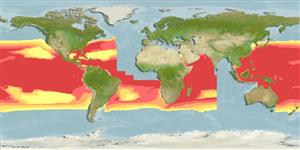>
Carangiformes (Jacks) >
Echeneidae (Remoras)
Etymology: Phtheirichthys: Greek, ptheiros, a fish that parasites other + Greek, ichthys = fish (Ref. 45335).
Environment: milieu / climate zone / depth range / distribution range
Ökologie
seewasser; ozeanodrom (Ref. 51243); tiefenbereich 0 - 5 m (Ref. 86942). Subtropical
Worldwide in tropical and subtropical waters. Western Atlantic: South Carolina, USA and northern Gulf of Mexico to northern South America (Ref. 7251). Western Central Pacific: Guam (Ref. 35720).
Size / Gewicht / Alter
Maturity: Lm ? range ? - ? cm
Max length : 76.0 cm TL Männchen/unbestimmt; (Ref. 2850)
Rückenflossenstacheln (insgesamt) : 0; Rückenflossenweichstrahlen (insgesamt) : 32 - 38; Afterflossenstacheln: 0; Afterflossenweichstrahlen: 31 - 38. Bluish black above, white below; 3 stripes along sides (upper pale blue, middle black, lower silvery).
Rare (Ref. 4389), oceanic species. Most often found attached to barracudas but also to other fishes and sea turtles. Clings to body of host and also found inside gill chambers.
Life cycle and mating behavior
Maturities | Fortpflanzung | Spawnings | Egg(s) | Fecundities | Larven
Heemstra, P.C., 1986. Echeneidae. p. 662-664. In M.M. Smith and P.C. Heemstra (eds.) Smiths' sea fishes. Springer-Verlag, Berlin. (Ref. 4389)
IUCN Rote Liste Status (Ref. 130435)
Bedrohung für Menschen
Harmless
Nutzung durch Menschen
Tools
Zusatzinformationen
Download XML
Internet Quellen
Estimates based on models
Preferred temperature (Ref.
123201): 20.9 - 29.1, mean 26.9 °C (based on 39944 cells).
Phylogenetic diversity index (Ref.
82804): PD
50 = 1.0039 [Uniqueness, from 0.5 = low to 2.0 = high].
Bayesian length-weight: a=0.00263 (0.00112 - 0.00620), b=3.17 (2.96 - 3.38), in cm total length, based on LWR estimates for this (Sub)family-body shape (Ref.
93245).
Trophic level (Ref.
69278): 3.6 ±0.5 se; based on size and trophs of closest relatives
Widerstandsfähigkeit (Ref.
120179): mittel, Verdopplung der Population dauert 1,4 - 4,4 Jahre. (Assuming Fec < 10,000).
Fishing Vulnerability (Ref.
59153): Moderate to high vulnerability (50 of 100).
